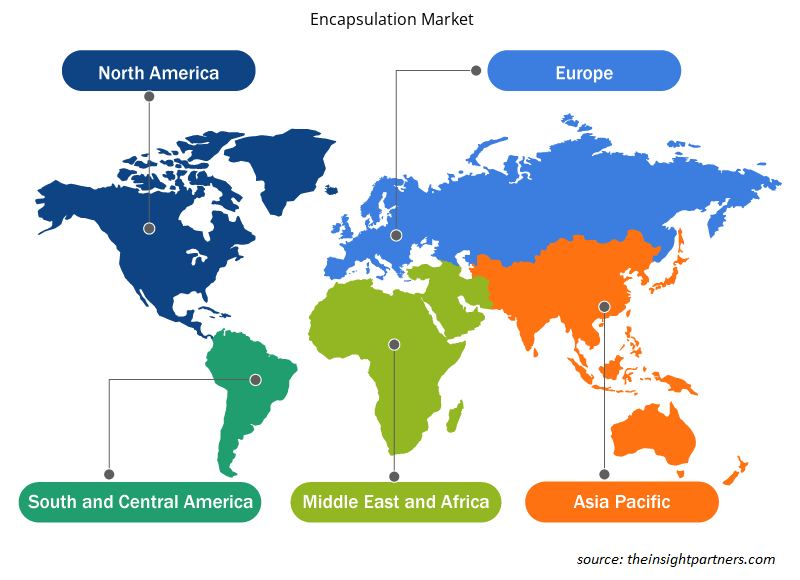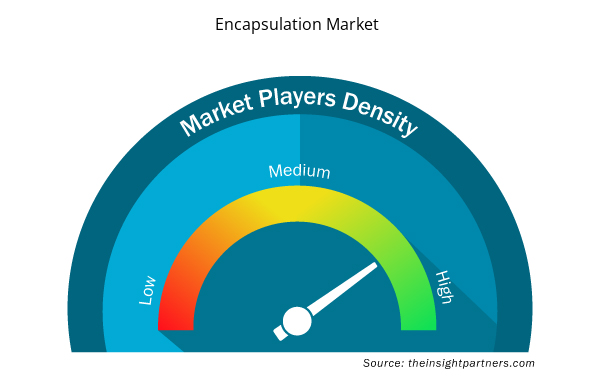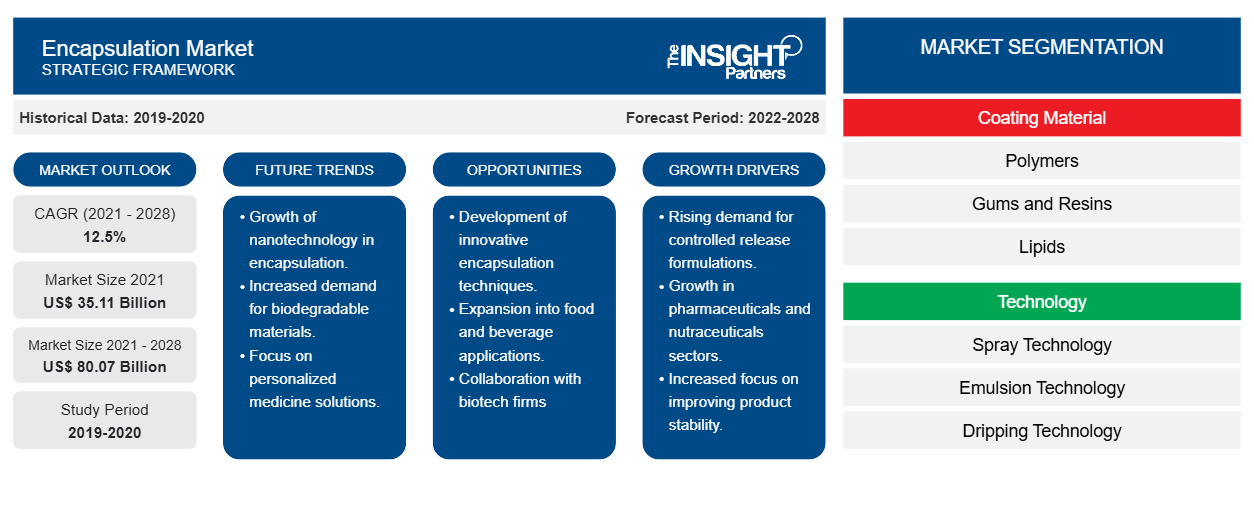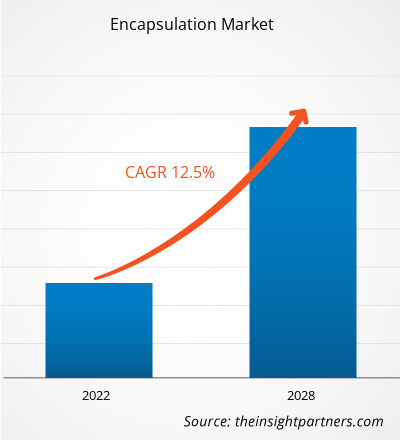Si prevede che il mercato dell'incapsulamento crescerà da 35.113,49 milioni di dollari nel 2021 a 80.071,65 milioni di dollari entro il 2028; si stima che crescerà a un CAGR del 12,5% dal 2021 al 2028.
La domanda di incapsulamento sta aumentando in modo significativo a causa della crescente domanda di aromi e colori incapsulati dal settore dei cibi pronti. Il mutevole ciclo di vita frenetico degli individui in tutto il mondo, insieme alla crescente popolazione urbana mondiale, determina la necessità di prodotti alimentari pronti. La domanda di prodotti farmaceutici incapsulati sta aumentando a causa del crescente carico di malattie, del miglioramento dei sistemi sanitari e dell'aumento dei redditi disponibili, che sta anche stimolando la crescita del mercato.
Si prevede che il mercato dell'incapsulamento nell'Asia Pacifica crescerà al CAGR più elevato durante il periodo di previsione. Molti paesi dell'Asia-Pacifico, come Cina e India, sono tra le popolazioni in più rapida crescita al mondo. L'industria alimentare si sta espandendo nella regione per la sua ampia gamma di applicazioni. L'esistenza di vari settori consolidati, come cibo e bevande, in Cina, India, Giappone e Corea del Sud ha aumentato la domanda di soluzioni di imballaggio nella regione. L'elevata domanda di integratori alimentari tra la popolazione più giovane sta guidando il mercato dell'incapsulamento. I principali componenti degli integratori alimentari, come vitamine ed enzimi, richiedono una consegna mirata. Alcuni fattori di tendenza come la consapevolezza della salute, la nutrizione e il benessere stanno guidando il comportamento dei consumatori per alimenti che supportano vite più lunghe e sane. La domanda di alimenti funzionali e integratori alimentari è in aumento tra la popolazione. Pertanto, con il crescente consumo di alimenti e bevande confezionati nella regione, si prevede che il mercato dell'incapsulamento nell'Asia Pacifica assisterà a una crescita significativa durante il periodo di previsione.
Personalizza questo report in base alle tue esigenze
Riceverai la personalizzazione gratuita di qualsiasi report, comprese parti di questo report, o analisi a livello nazionale, pacchetto dati Excel, oltre a usufruire di grandi offerte e sconti per start-up e università
- Scopri le principali tendenze di mercato in questo rapporto.Questo campione GRATUITO includerà analisi di dati che spaziano dalle tendenze di mercato alle stime e alle previsioni.
Impatto della pandemia di COVID-19 sul mercato dell'incapsulamento
Con lo scoppio del COVID-19 in tutto il mondo, la maggior parte dei paesi ha dichiarato un'emergenza sanitaria e ha interrotto i movimenti non essenziali. La crisi ha avuto un impatto pesante sulla catena di fornitura dei beni. Nel mezzo della crisi, c'è un aumento della domanda di cibo e bevande sani da parte dei consumatori per rafforzare l'immunità. La pandemia di COVID-19 ha avuto un impatto negativo sul mercato globale dell'incapsulamento a causa della chiusura delle unità di produzione, dell'aumento dei prezzi delle materie prime, della carenza di manodopera, dell'interruzione delle catene di fornitura e dell'instabilità finanziaria. Inoltre, i governi di vari paesi stanno pianificando di sviluppare infrastrutture moderne e tecnologicamente avanzate per mitigare gli impatti economici della pandemia di COVID-19. Pertanto, aiuta a contribuire alla crescita del settore delle costruzioni, che aumenterebbe la domanda di incapsulamento nei prossimi anni. Si prevede che questa pandemia avrà un impatto basso sul mercato. Tuttavia, con l'allentamento delle norme, che sono state adottate per controllare la diffusione del virus, il mercato è ripreso con le precauzioni necessarie.
Approfondimenti di mercato
Crescente domanda di aromi e colori incapsulati nel settore dei cibi pronti
L'incapsulamento può fornire proprietà funzionali come il rilascio controllato in ambienti predeterminati. Gli aromi incapsulati sono ampiamente utilizzati nel settore del cibo pronto per il rilascio controllato di aromi e colori nei prodotti alimentari, tra cui bustine di tè, dolciumi, bevande istantanee e dessert. Il ciclo di vita frenetico e mutevole degli individui a livello globale e la crescente popolazione urbana in tutto il mondo determinano la necessità di prodotti alimentari pronti. Il settore del cibo pronto è costituito da prodotti alimentari progettati per ridurre i tempi di preparazione per l'utente finale. Il settore del cibo pronto ha assistito a un aumento sostanziale della domanda nell'ultimo decennio a livello globale e si prevede che aumenterà in modo significativo durante il periodo di previsione.
Approfondimenti sui materiali di rivestimento
In base al materiale di rivestimento, il mercato dell'incapsulamento è segmentato in polimeri, gomme e resine, lipidi, carboidrati e proteine. Il segmento dei carboidrati ha rappresentato la quota di mercato maggiore nel 2020, mentre si prevede che il segmento dei polimeri registrerà il CAGR più elevato nel mercato durante il periodo di previsione. I carboidrati sono i primi polimeri utilizzati per l'incapsulamento degli aromi grazie alle loro buone proprietà fisico-chimiche, alla buona solubilità in acqua, alla bassa viscosità e alle eccellenti proprietà barriera rispetto ai composti organici volatili. Il materiale di rivestimento per i carboidrati è costituito da amido, maltodestrine, chitosano, solidi di sciroppo di mais, destrano, amido modificato , fruttosio e ciclodestrine. L'incapsulamento dei polimeri è utilizzato nell'industria farmaceutica per farmaci somministrati per via orale e per mascherare il gusto e l'odore per migliorare la compliance del paziente e ridurre l'irritazione e la tossicità gastrointestinale.
Approfondimenti tecnologici
In base alla tecnologia, il mercato dell'incapsulamento è segmentato in tecnologia spray, tecnologia emulsione, tecnologia gocciolante e altre. Il segmento della tecnologia spray ha rappresentato la quota di mercato maggiore nel 2020. La tecnologia spray prevede la nebulizzazione di una soluzione acquosa in aria calda, che offre una maggiore efficienza. I vettori più consigliati per lo sviluppo di particelle mediante tecnologia spray nelle industrie alimentari sono alcoli, acidi grassi, triacilgliceroli e cere. La tecnologia emulsione intrappola materiale sensibile, come minerali e vitamine, nel vettore o nel materiale di rivestimento prima di essere aggiunto al cibo. Pertanto, consente ai nutrienti di essere abbastanza stabili e facilmente dispersi nel mezzo. Pertanto, la crescente domanda da parte del settore dei cibi pronti per aromi e alimenti incapsulati sta guidando la crescita del mercato globale dell'incapsulamento.
Approfondimenti sulle applicazioni
In base all'applicazione, il mercato dell'incapsulamento è segmentato in prodotti farmaceutici e nutraceutici, alimenti e bevande, prodotti per la cura della persona, prodotti agrochimici e altri. Si prevede che il mercato per il segmento farmaceutico e nutraceutico crescerà nei prossimi anni a causa del gran numero di aziende che utilizzano l'incapsulamento per mascherare il sapore o l'odore amaro dei farmaci e per fornire la loro somministrazione mirata e controllata. Anche il settore farmaceutico è fortemente influenzato dalle tecnologie di incapsulamento a causa dei vantaggi ottenuti dai produttori. L'incapsulamento per gli alimenti consente la ritenzione del sapore e rimuove il cattivo gusto. La crescente preferenza dei consumatori per alimenti sani e convenienti, la crescente domanda di alimenti confezionati e il cambiamento dello stile di vita, insieme alla preferenza per gli alimenti pronti, dovrebbero alimentare la crescita del mercato globale durante il periodo di previsione.
Alcuni attori che operano nel mercato dell'incapsulamento sono Encapsys, LLC; Lycored; Tastetech; Givadan; Balchem, INC; FrieslandCampina; DSM; Microtek Laboratories, INC; Legris Industries Group; e BASF SE. Le aziende chiave adottano strategie come fusioni e acquisizioni, ricerca e sviluppo per espandere la base clienti e ottenere una quota significativa nel mercato globale, il che consente loro anche di mantenere il loro marchio a livello globale.
Segnala i riflettori
- Tendenze industriali progressive nel mercato dell'incapsulamento per aiutare gli operatori a sviluppare strategie efficaci a lungo termine
- Strategie di crescita aziendale adottate dai mercati sviluppati e in via di sviluppo
- Analisi quantitativa del mercato dell'incapsulamento dal 2018 al 2028
- Stima della domanda globale di incapsulamento
- Analisi PEST per illustrare l'efficacia degli acquirenti e dei fornitori che operano nel settore
- Sviluppi recenti per comprendere lo scenario competitivo del mercato
- Tendenze e prospettive del mercato, nonché fattori che guidano e frenano la crescita del mercato dell'incapsulamento
- Assistenza nel processo decisionale evidenziando le strategie di mercato che sostengono l'interesse commerciale, portando alla crescita del mercato
- La dimensione del mercato dell'incapsulamento in vari nodi
- Panoramica dettagliata e segmentazione del mercato, nonché dinamiche del settore dell'incapsulamento
- Dimensioni del mercato dell'incapsulamento in varie regioni con promettenti opportunità di crescita
Approfondimenti regionali sul mercato dell'incapsulamento
Le tendenze regionali e i fattori che influenzano il mercato dell'incapsulamento durante il periodo di previsione sono stati ampiamente spiegati dagli analisti di Insight Partners. Questa sezione discute anche i segmenti e la geografia del mercato dell'incapsulamento in Nord America, Europa, Asia Pacifico, Medio Oriente e Africa e America meridionale e centrale.

- Ottieni i dati specifici regionali per il mercato dell'incapsulamento
Ambito del rapporto sul mercato dell'incapsulamento
| Attributo del report | Dettagli |
|---|---|
| Dimensioni del mercato nel 2021 | 35,11 miliardi di dollari USA |
| Dimensioni del mercato entro il 2028 | 80,07 miliardi di dollari USA |
| CAGR globale (2021 - 2028) | 12,5% |
| Dati storici | 2019-2020 |
| Periodo di previsione | 2022-2028 |
| Segmenti coperti | Per materiale di rivestimento
|
| Regioni e Paesi coperti | America del Nord
|
| Leader di mercato e profili aziendali chiave |
|
Densità degli attori del mercato: comprendere il suo impatto sulle dinamiche aziendali
Il mercato dell'Encapsulation Market sta crescendo rapidamente, spinto dalla crescente domanda degli utenti finali dovuta a fattori quali l'evoluzione delle preferenze dei consumatori, i progressi tecnologici e una maggiore consapevolezza dei vantaggi del prodotto. Con l'aumento della domanda, le aziende stanno ampliando le loro offerte, innovando per soddisfare le esigenze dei consumatori e capitalizzando sulle tendenze emergenti, il che alimenta ulteriormente la crescita del mercato.
La densità degli operatori di mercato si riferisce alla distribuzione di aziende o società che operano in un particolare mercato o settore. Indica quanti concorrenti (operatori di mercato) sono presenti in un dato spazio di mercato in relazione alle sue dimensioni o al valore di mercato totale.
Le principali aziende che operano nel mercato dell'incapsulamento sono:
- Encapsys, LLC
- Licorato
- Tecnologia del gusto
- Givadan
- Balchem, INC
Disclaimer : le aziende elencate sopra non sono classificate secondo un ordine particolare.

- Ottieni una panoramica dei principali attori del mercato dell'incapsulamento
Mercato dell'incapsulamento - per materiale di rivestimento
- Polimeri
- Gomme e Resine
- Lipidi
- Carboidrati
- Proteine
Mercato dell'incapsulamento – per tecnologia
- Tecnologia a spruzzo
- Tecnologia dell'emulsione
- Tecnologia di gocciolamento
- Altri
Mercato dell'incapsulamento - per applicazione
- Farmaceutica e nutraceutica
- Cibo e bevande
- Prodotti per la cura della persona
- Prodotti agrochimici
- Altri
Profili aziendali
- Azienda
- Licorato
- GustoTech
- Marchio Givaudan
- Società per azioni Balchem Inc.
- FrisiaCampina
- BASF SE
- Il DSM-5
- Microtek Laboratories, Inc.
- Gruppo Legris Industries
- Analisi storica (2 anni), anno base, previsione (7 anni) con CAGR
- Analisi PEST e SWOT
- Valore/volume delle dimensioni del mercato - Globale, regionale, nazionale
- Industria e panorama competitivo
- Set di dati Excel



Report Coverage
Revenue forecast, Company Analysis, Industry landscape, Growth factors, and Trends

Segment Covered
This text is related
to segments covered.

Regional Scope
North America, Europe, Asia Pacific, Middle East & Africa, South & Central America

Country Scope
This text is related
to country scope.
Domande frequenti
Asia Pacific is estimated to register the fastest CAGR in the global encapsulation market over the forecast period. In the region, the demand for encapsulated ingredients is fueled by increasing application in various industries such as food and beverages, pharmaceutical and nutraceuticals, personal care products, agrochemicals etc. Moreover, the consumer demand for longer lasting fragrances in their everyday products continues to grow in all categories, this is expected to offer more growth opportunities for the market.
The pharmaceuticals and nutraceutical segment led the global encapsulation market in 2021. Encapsulation technologies are extensively used by pharmaceutical and nutraceuticals companies to mask the bitter taste or smell of drugs and to provide their targeted and controlled delivery. The demand for encapsulated biomolecules is increasing in the pharmaceutical industry as they provide targeted action.
The spray technology segment led the global encapsulation market in 2021. This technology involves the spraying of an aqueous solution in hot air, which delivers higher efficiency. The technology is used in the food and pharmaceutical industries, which helps produce high-quality powders with low moisture content, resulting in a wide range of shelf-stable food and other biologically significant products. The spray drying method is primarily used in microencapsulation due to the rapid processing at a low cost, a wide choice of coating material, good encapsulation efficiency, stability of the finished product, and the possibility of large-scale production in the continuous mode.
The carbohydrates segment held the largest share in 2021. Carbohydrates such as starch, agar, chitosan, and others are popular encapsulation materials in the F&B industry. Encapsulation is used in the food products to lock the flavors or encapsulating ingredients, enzymes, cells, or other things in tiny capsules. Applications for this process have grown in the food sector because encapsulated materials may be protected against moisture, heat, and other severe environments, increasing their stability and viability.
The major players operating in the global encapsulation market market are Encapsys,LLC; Lycored; Tastetech; Givadan; Balchem, INC; FrieslandCampina; DSM; Microtek Laborotories INC; Legris Industries Group; BASF SE; and many others.
In 2021, North America accounted for the largest share of the global encapsulation market. The growth of the encapsulation market in this region is primarily attributed to the rise of the pharmaceutical sector in the. U.S. is one of the largest hubs for pharma and food industries in the world. In addition, the country is also technologically advanced and has been a major market of encapsulation since a long time. The increasing demand for pharmaceutical drugs and nutraceutical products is likely to offer lucrative opportunities to manufacturers globally.
Trends and growth analysis reports related to Chemicals and Materials : READ MORE..
The List of Companies - Encapsulation Market
- Encapsys,LLC
- Lycored
- Tastetech
- Givadan
- Balchem, INC
- FrieslandCampina
- DSM
- Microtek Laborotories, INC
- Legris Industries Group
- BASF SE
The Insight Partners performs research in 4 major stages: Data Collection & Secondary Research, Primary Research, Data Analysis and Data Triangulation & Final Review.
- Data Collection and Secondary Research:
As a market research and consulting firm operating from a decade, we have published and advised several client across the globe. First step for any study will start with an assessment of currently available data and insights from existing reports. Further, historical and current market information is collected from Investor Presentations, Annual Reports, SEC Filings, etc., and other information related to company’s performance and market positioning are gathered from Paid Databases (Factiva, Hoovers, and Reuters) and various other publications available in public domain.
Several associations trade associates, technical forums, institutes, societies and organization are accessed to gain technical as well as market related insights through their publications such as research papers, blogs and press releases related to the studies are referred to get cues about the market. Further, white papers, journals, magazines, and other news articles published in last 3 years are scrutinized and analyzed to understand the current market trends.
- Primary Research:
The primarily interview analysis comprise of data obtained from industry participants interview and answers to survey questions gathered by in-house primary team.
For primary research, interviews are conducted with industry experts/CEOs/Marketing Managers/VPs/Subject Matter Experts from both demand and supply side to get a 360-degree view of the market. The primary team conducts several interviews based on the complexity of the markets to understand the various market trends and dynamics which makes research more credible and precise.
A typical research interview fulfils the following functions:
- Provides first-hand information on the market size, market trends, growth trends, competitive landscape, and outlook
- Validates and strengthens in-house secondary research findings
- Develops the analysis team’s expertise and market understanding
Primary research involves email interactions and telephone interviews for each market, category, segment, and sub-segment across geographies. The participants who typically take part in such a process include, but are not limited to:
- Industry participants: VPs, business development managers, market intelligence managers and national sales managers
- Outside experts: Valuation experts, research analysts and key opinion leaders specializing in the electronics and semiconductor industry.
Below is the breakup of our primary respondents by company, designation, and region:

Once we receive the confirmation from primary research sources or primary respondents, we finalize the base year market estimation and forecast the data as per the macroeconomic and microeconomic factors assessed during data collection.
- Data Analysis:
Once data is validated through both secondary as well as primary respondents, we finalize the market estimations by hypothesis formulation and factor analysis at regional and country level.
- Macro-Economic Factor Analysis:
We analyse macroeconomic indicators such the gross domestic product (GDP), increase in the demand for goods and services across industries, technological advancement, regional economic growth, governmental policies, the influence of COVID-19, PEST analysis, and other aspects. This analysis aids in setting benchmarks for various nations/regions and approximating market splits. Additionally, the general trend of the aforementioned components aid in determining the market's development possibilities.
- Country Level Data:
Various factors that are especially aligned to the country are taken into account to determine the market size for a certain area and country, including the presence of vendors, such as headquarters and offices, the country's GDP, demand patterns, and industry growth. To comprehend the market dynamics for the nation, a number of growth variables, inhibitors, application areas, and current market trends are researched. The aforementioned elements aid in determining the country's overall market's growth potential.
- Company Profile:
The “Table of Contents” is formulated by listing and analyzing more than 25 - 30 companies operating in the market ecosystem across geographies. However, we profile only 10 companies as a standard practice in our syndicate reports. These 10 companies comprise leading, emerging, and regional players. Nonetheless, our analysis is not restricted to the 10 listed companies, we also analyze other companies present in the market to develop a holistic view and understand the prevailing trends. The “Company Profiles” section in the report covers key facts, business description, products & services, financial information, SWOT analysis, and key developments. The financial information presented is extracted from the annual reports and official documents of the publicly listed companies. Upon collecting the information for the sections of respective companies, we verify them via various primary sources and then compile the data in respective company profiles. The company level information helps us in deriving the base number as well as in forecasting the market size.
- Developing Base Number:
Aggregation of sales statistics (2020-2022) and macro-economic factor, and other secondary and primary research insights are utilized to arrive at base number and related market shares for 2022. The data gaps are identified in this step and relevant market data is analyzed, collected from paid primary interviews or databases. On finalizing the base year market size, forecasts are developed on the basis of macro-economic, industry and market growth factors and company level analysis.
- Data Triangulation and Final Review:
The market findings and base year market size calculations are validated from supply as well as demand side. Demand side validations are based on macro-economic factor analysis and benchmarks for respective regions and countries. In case of supply side validations, revenues of major companies are estimated (in case not available) based on industry benchmark, approximate number of employees, product portfolio, and primary interviews revenues are gathered. Further revenue from target product/service segment is assessed to avoid overshooting of market statistics. In case of heavy deviations between supply and demand side values, all thes steps are repeated to achieve synchronization.
We follow an iterative model, wherein we share our research findings with Subject Matter Experts (SME’s) and Key Opinion Leaders (KOLs) until consensus view of the market is not formulated – this model negates any drastic deviation in the opinions of experts. Only validated and universally acceptable research findings are quoted in our reports.
We have important check points that we use to validate our research findings – which we call – data triangulation, where we validate the information, we generate from secondary sources with primary interviews and then we re-validate with our internal data bases and Subject matter experts. This comprehensive model enables us to deliver high quality, reliable data in shortest possible time.


 Ottieni un campione gratuito per questo repot
Ottieni un campione gratuito per questo repot